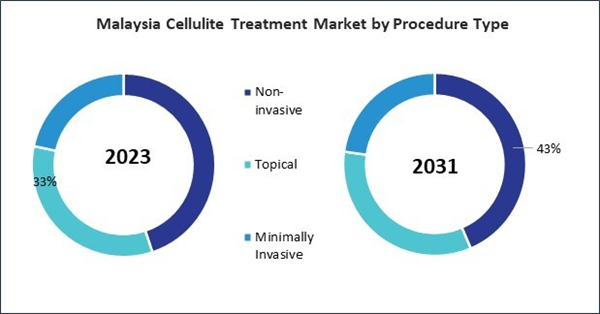The China market dominated the Asia Pacific Cellulite Treatment Market by Country in 2023, and would continue to be a dominant market till 2031; thereby, achieving a market value of $284.2 Million by 2031. The Japan market is registering a CAGR of 10.5% during (2024 - 2031). Additionally, The India market would experience a CAGR of 11.9% during (2024 - 2031).
Lifestyle factors significantly influence the development of cellulite; as the prevalence of these factors rises, so does the demand for cellulite treatments. A poor diet, insufficient physical activity, and hormonal fluctuations are among the most significant lifestyle factors that contribute to the development of cellulite. The dimpled appearance of cellulite can result from the connective tissue beneath the skin being compressed by this excess fat. The prevalence of cellulite escalates in tandem with the prevalence of unhealthy dietary practices, thereby stimulating the need for treatment alternatives.
An additional lifestyle element that may contribute to the formation of cellulite is inactivity. As sedentary lifestyles become more prevalent, there is a growing need for cellulite treatments that can mitigate the detrimental effects of inactivity. Additionally, hormonal fluctuations that transpire during menopause, pregnancy, and puberty may contribute to the formation of cellulite. Cellulite may become more apparent as a result of alterations in the structure of the skin and connective tissue brought about by hormonal fluctuations. As hormonal imbalances become more common, particularly with the rise of conditions such as polycystic ovary syndrome (PCOS), the demand for cellulite treatment options that can help manage these changes increases.
In East and North-East Asia, where one in three people over 60 will be female, there may be a particularly high demand for cellulite treatment among women, as they are more likely to seek out cosmetic procedures to address aging-related concerns. As a result, this region offers profitable market growth opportunities for the entire projection period.
Based on Gender, the market is segmented into Female and Male. Based on Procedure Type, the market is segmented into Non-invasive, Topical, and Minimally Invasive. Based on Cellulite Type, the market is segmented into Soft Cellulite, Hard Cellulite and Edematous. Based on End User, the market is segmented into Clinics & Beauty Centers, Hospitals and Others. Based on countries, the market is segmented into China, Japan, India, South Korea, Singapore, Malaysia, and Rest of Asia Pacific.
List of Key Companies Profiled
- Candela Corporation (Syneron Medical)
- Bausch Health Companies, Inc.
- Sinclair Pharma Ltd. (Huadong Medicine Co., Ltd.)
- AbbVie, Inc.
- Cynosure, LLC (Clayton, Dubilier & Rice, LLC)
- Hologic, Inc.
- Galderma S.A.
- Zimmer MedizinSysteme GmbH
- Endo International PLC
- Merz Pharma GmbH & Co. KGaA
Market Report Segmentation
By Gender- Female
- Male
- Non-invasive
- Topical
- Minimally Invasive
- Soft Cellulite
- Hard Cellulite
- Edematous
- Clinics & Beauty Centers
- Hospitals
- Others
- China
- Japan
- India
- South Korea
- Singapore
- Malaysia
- Rest of Asia Pacific
Table of Contents
Companies Mentioned
- Candela Corporation (Syneron Medical)
- Bausch Health Companies, Inc.
- Sinclair Pharma Ltd. (Huadong Medicine Co., Ltd.)
- AbbVie, Inc.
- Cynosure, LLC (Clayton, Dubilier & Rice, LLC)
- Hologic, Inc.
- Galderma S.A.
- Zimmer MedizinSysteme GmbH
- Endo International PLC
- Merz Pharma GmbH & Co. KGaA
Methodology

LOADING...









